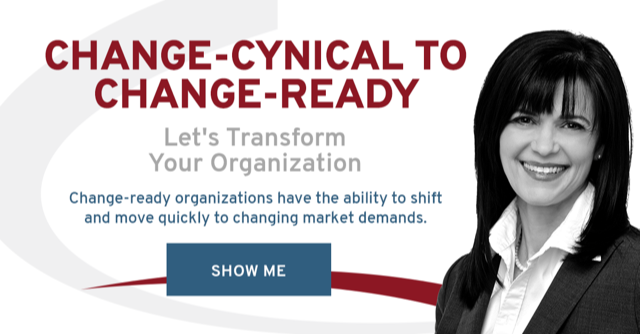By: Dr. Dawn-Marie Turner
In a previous blog post I said the more changes you launch the less likely any one will be successful. I made the argument that to get greater change in your organization you need to launch less change initiatives.
Ok, so you are working to reduce the number of change initiatives. But how do you know if you are getting a return on your investment?
The obvious answer is measurement. What you measure is not obvious.
The number of change initiates is not a good measure of how much change is occurring in your organization.
One common measure of success is the number of changes implemented. However using the number of changes implemented as a measure of success is misleading. It doesn’t tell you if the new activities and behaviours are sustainable. To know if your change is sustainable you need to measure the level of adoption.
It’s easy to understand why leaders associate the number of changes being implemented with the amount of change occurring. For leaders each change initiatives successfully implemented equals change for the organization.
I still see a kind of build it and they will come mentality. Or worse, a build and they will have to come mentality. As if employees don’t have a choice.
But they do.
The statistics are a little scary. A 2013 survey of 2200 executives found only about 54 percent said their change initiatives were adopted and sustained. Research from Harvard Business School found about one third of the changes organizations attempted made the situation worse instead of better. To use change to increase growth, performance, and your bottom line your organization must be able to sustain the behaviours and activities associated with the desired outcome.
The failure to sustain change leads to Yo-Yo change
Failing to sustain the changes you initiate leads to Yo-Yo change.
Yo-yo changes are those changes you implement only to find a few weeks, or months later people have reverted back to their old behaviours and activities. Most of us are familiar with yo-yo dieting. You are continually going on a diet to lose the same weight you lost with your previous diet, plus any addition weight you gained after you stopped dieting.
 It’s similar in your organization. You continually launch new initiatives in an effort to achieve the same behaviours and activities that weren’t sustained from the last change. Like yo-yo dieting, change becomes more and more difficult.
It’s similar in your organization. You continually launch new initiatives in an effort to achieve the same behaviours and activities that weren’t sustained from the last change. Like yo-yo dieting, change becomes more and more difficult.
Yo-yo change erodes trust, breeds’ cynicism, and disrupts your organization. It prevents your organization from using change to increase growth and performance. It also increases your risk of change fatigue. In the same survey mentioned previously, CEOs stated change fatigue as one of the major reasons for organizational change failure.
Adoption is the key to getting off the Yo-yo change cycle.
Implementation of a change event leads to adaptation, not adoption.
Any organization can implement change. However, only the organizations that sustain the new behaviours, and activities can use change to increase growth and performance. Your focus with any change should be integration not just implementation.
When you focus on integration instead of implementation you create the opportunity for healthy organizational change. Your goal becomes adoption versus adaptation of the new behaviours and activities.
Adoption and adaptation are not the same. When we adapt to a new situation we hold out the hope that things will go back to the way they were. We also create work-arounds so the new situation feels and performs more like the old.
For example, the new technology you successfully implemented, but then tweaked so employees could use it like the old technology. Or with that new LEAN business process you implemented. You notice that after a couple of months its starting to look and feel like the old process. It’s just packaged differently.
These are just some of the indicators that employees are adapting, but not adopting the new situation. It’s only when the new environment has become our normal environment that the change will be sustained.
Complete an adoption assessment
People don’t adopt new behaviours and activities by completing a series of tasks or deliverables. To adopt new behaviours and activities we need three things. First, we need to actively use the new behaviours and activities. Second, we need time – time for the new to become the normal. Finally, we need support and reinforcement.
It’s the period after people have been trained, and are engaging in the activities and behaviours that you are the most vulnerable. It’s also at this time most leaders identify a change initiative as complete. Because people are engaging in the activities or behaviour they claim a successful implementation.
However, at this point the new behaviours, or activities are still just that – new. They have not yet become normal. Until the new becomes the normal there is a risk of sliding back. That’s why level of adoption is a better measure of whether your change is successful.
Conducting an adoption assessment before you claim victory is essential. Here are three questions from “Launch Lead Live: The executive’s guide to preventing resistance to change” that can help you assess the level of adoption:
- Are people engaging in the new behaviours and activities consistent with the intended outcome?
- What level of comfort or ease do they express with the new behaviours and activities?
- Are people talking about a desire to return to the old behaviours and activities?
To learn more about adoption assessments give us a call at 204-415-4278 or fill out the form below.
We would love to hear from you! Please fill out this form and we will get in touch with you shortly.
Helping you move change from a liability to an asset.






